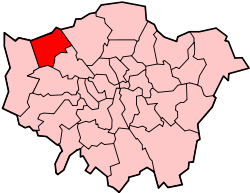Harrow on the Hill
Harrow on the Hill is a locality and historic village in the borough of Harrow in Greater London, England.[3] Independent boutiques and restaurants dot the affluent area[4], which is rich with historic architecture; offering a village atmosphere. The name refers to Harrow Hill, 408 feet (124 m).[5] It is located some half a mile south from the modern town of Harrow. Harrow School is located in the area.[6]
| Harrow on the Hill | |
|---|---|
 Harrow-on-the-Hill High Street (36-40 in picture), with the spire of St Mary's Church visible in the background At Centre: Listed Drinking Fountain[1] | |
 Harrow on the Hill Location within Greater London | |
| Population | 12,270 (2011 Census.Ward)[2] |
| OS grid reference | TQ155865 |
| London borough | |
| Ceremonial county | Greater London |
| Region | |
| Country | England |
| Sovereign state | United Kingdom |
| Post town | HARROW |
| Postcode district | HA1 |
| Dialling code | 020 |
| Police | Metropolitan |
| Fire | London |
| Ambulance | London |
| London Assembly | |
Etymology
Etymology before 1398 derives from Harrow, & The Saxon Chronicles/The Peterborough Chronicle, which first recorded Harrow Hill in 767 as Gumeninga Hergae. A suggested meaning is heathen temple of a tribe called the Gumeningas', sons of Gumen. One of the earliest recorded uses of the name is found in 1398 as Harrowe atte Hille. The hill has historically been used as a place of pagan worship.[5] It is alternatively explained to mean the church upon the hill.[7]
History
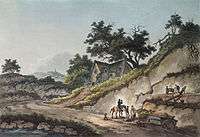
Harrow on the Hill formed an ancient parish and later civil parish in the Gore hundred of Middlesex.[8] In 1831 it had a population of 3,861 and occupied an area of 9,870 acres (39.9 km2). There were significant boundary changes in 1894, when the bulk of the parish was removed to create the parishes of Harrow Weald, Wealdstone and Wembley.[8] By this time the hamlet of Greenhill to the north had developed into what would become the modern town of Harrow.
By 1931 it occupied a reduced area of 2,129 acres (8.62 km2) and had a population of 26,380. It formed the Harrow on the Hill Urban District of Middlesex from 1894 and was abolished by a County Review Order in 1934,[9] with the bulk of the area forming part of a new civil parish and urban district of Harrow. In 1954 the urban district was incorporated as the Municipal Borough of Harrow and in 1965 it was transferred to Greater London to form the London Borough of Harrow.
King Charles I
On 27 April 1646, King Charles I, when fleeing Oxford on his way to Southwell, where he was due to surrender to the Scottish Army, stopped at Harrow on the Hill near St Mary's Church, so that he could take a final glimpse at London and also to water his horses. A plaque on Grove Hill near Harrow School marks the spot, and also says that the spring below has ever since been called King Charles' Well.[10]
Photo record
The Hills & Saunders photography company had a studio on Harrow on the Hill from the 1860s photographing the schools, families and local area. The archive of c. 80,000 glass plates still exists and much of it can be seen today online at the Harrow Photos website.[11]
Demography
The population of the Harrow on the Hill ward of the London Borough of Harrow was 9,578 in 1991 and 10,632 in 2001. It occupies an area of 357 hectares though the hill itself occupies approximately 100 hectares (250 acres) and in 2001 had a population density of 29.74 persons per hectare. There were 4,539 households in the district in 2001.[12] The ward's boundaries encompass the majority of the hill and also Roxeth, Sudbury Hill and parts of West Harrow.
The 2011 census showed ethnically Whites were largest at 47.3% (34.4% British, 9.6% "Other White" excluding Irish), 35.4% were Asian (19.1% Indian, 11.6% "Other Asian"). The most spoken foreign languages were Gujarati followed by Tamil.[13] The Asian community in Harrow is among the wealthiest.[14][15] Of the over 4,500 households, the amount of whole house/bungalow and of flat/maisonette accommodations are about evenly split; 57.6% of property tenures are owned, 28.8% are privately rented, and 13.8% are socially rented. A relatively large share of residents, 28.4%, have a professional occupation. The unemployment rate for working people was 4.1%. The median age was 33.5 years.[16]
Gallery
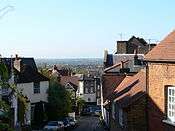 West Street
West Street
By the drinking fountain
Aspect: west_-_geograph.org.uk_-_175017.jpg) View of the north of the High Street
View of the north of the High Street
Taken from the junction of Church Hill
Some of the buildings are those of Harrow School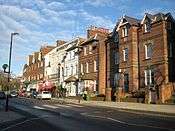 The High Street
The High Street
A marginally lower section nearby to the south, in the conservation area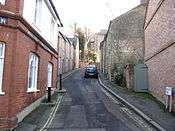
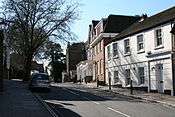 High Street - the south end
High Street - the south end Former public house and coaching inn
Former public house and coaching inn The Castle, West Street
The Castle, West Street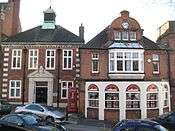 The former fire station (right) now an estate agent, and on the left the former headquarters of Harrow Urban District (now the London Borough of Harrow)
The former fire station (right) now an estate agent, and on the left the former headquarters of Harrow Urban District (now the London Borough of Harrow) Partial Panorama looking northwest towards Pinner (left) and Headstone (right) from building at the bottom of the northern downslope of Harrow on the Hill (200m north of the mainline station) - the listed building on the left in the foreground is 315 Station Road, Harrow,
Partial Panorama looking northwest towards Pinner (left) and Headstone (right) from building at the bottom of the northern downslope of Harrow on the Hill (200m north of the mainline station) - the listed building on the left in the foreground is 315 Station Road, Harrow,
closest to the hill itself, currently occupied by NatWest[17]- St. Mary's Church
The parish church  Clementine Churchill Hospital
Clementine Churchill Hospital
The local private hospital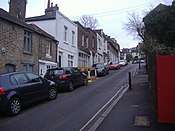 West Street
West Street High Street
High Street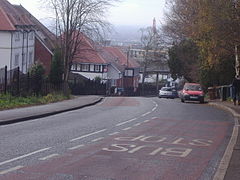 Roxeth Hill
Roxeth Hill
Religion
Harrow on the Hill is also an ecclesiastical parish with St. Mary's, Harrow on the Hill at the apex. It was consecrated by St Anselm in 1094.[18] There is also a Roman Catholic parish church at the foot of the hill, Our Lady and St Thomas of Canterbury, Harrow, dedicated to Our Lady and St Thomas of Canterbury.[19]
Churchfields, Harrow on the Hill, centre of the Harrow Pentagram: Hergae Mound Oak trees leading from the Yew tree grove in Churchfields to the (Leyline-linked)Yew tree grove in St Mary's Church. Hergae Mound is also a direct flight line for pipistrelle bats and barn owls - very active at dusk. The Harrow Pentagram: Centre is St. Mary's at Harrow-on-the-hill. The five points around it are: Belmont Hill Stanmore, Horsenden Hill Greenford, Barn Hill Wembley, Dabbs Hill, St. John's Pinner.
First, Harrow on the Hill's original name 'Gumeninga hergae' suggests that the pagan practises may have still been taking place on the hill – despite increasing conversion to Christianity at the time. At the same time, and more significantly, Harrow on the Hill and St. Mary's that now stands on it, also serves as an example of something that may have been widespread at the time of its construction – namely the replacement of a pagan temple by a Christian church. This practice, in rhetoric at least, is not unheard of. In the sixth and seventh centuries, Pope Gregory the Great called in his pursuit of pagan conversion churches to be built on previously pagan sites. However, St. Mary's could well be an artefact of this practice – one of the few that explicitly link back to this conversion period and Christianity's approach to pagan cultures.
Harrow's famous hill, then, has significance well beyond the borders of the borough, and indeed, well beyond the borders of London. The hill, and its church, are access points – potential access points albeit – to the ancient people that are the roots and origin of the nation today, and to a time when this people underwent a considerable transformation, one that's impact continues to be seen in the present. It's something to think about, at least – not only that our old hill may have national importance, but that, when we walk its steep pastures, we tread on the site of a by-gone, medieval culture, on raw history buried in the soil. [credit Harrow Thurman]
The area has four Catholic schools and three Church of England schools.
Transport

Harrow-on-the-Hill station, although named after the settlement, is located some distance to the north of the hill. The London Underground service at Harrow-on-the-Hill is provided by the Metropolitan line, and the station is also served by the Chiltern Railways London to Aylesbury Line. These services run in to central London, and out west/north west to the outer reaches of London and beyond.
About equidistant to Harrow-on-the-Hill station from the top of the hill, is South Harrow on the Piccadilly line. The 258 and H17 London bus routes run over Harrow on the Hill itself.
Street accident fatality
A roadside plaque unveiled on 25 February 1969 states that the first recorded motor accident in Great Britain to have involved the death of the car driver took place at Harrow on the Hill on a road called Grove Hill seventy years earlier, on 25 February 1899.[20] The plaque makes no mention of the name of the dead motorist, but it does name the civic dignitary who unveiled it: his name is given as Alderman Charles Stenhouse, who was Mayor of Harrow at the time.[20]
The driver involved in the crash was 31-year-old engineer Edwin Sewell, driving a 6HP Daimler. A rear wheel collapsed after breaking its rim and the car hit a sturdy brick wall. Sewell was killed immediately when he and his passenger, a Major Richer, were thrown from the vehicle. Richer died three days later in hospital.[21]
Railway accident fatality
In the graveyard of St Mary's church is a gravestone recording the death of Thomas Port, from a railway accident on 7 August 1838.
Geography
References
- Historic England. "Details from listed building database (1193585)". National Heritage List for England. Retrieved 30 June 2012.
- "Harrow Ward population 2011". Neighbourhood Statistics. Office for National Statistics. Retrieved 23 October 2016.
- Harrow London Borough Council - Harrow on the Hill Village Conservation Area
- Socio-economic statistics for Harrow on the Hill, Harrow - iLiveHere accessed - July 11, 2020
- Mills, A., Dictionary of London Place Names, (2001)
- Wink, Bri (25 January 2017). "Neighbourhood Guide: Harrow on the Hill". International Student Blog |. Retrieved 19 June 2019.
- Harrow on the Hill, The Environs of London: volume 2: County of Middlesex, (1795). Date accessed: 1 January 2008.
- Vision of Britain - Harrow on the Hill parish Archived 30 September 2008 at the Wayback Machine (historic map Archived 30 September 2008 at the Wayback Machine)
- Vision of Britain - Harrow on the Hill UD Archived 30 September 2008 at the Wayback Machine
- "Harrow-on-the-Hill - Surrey Medieval". Wordpress. Retrieved 1 November 2014.
- Hills & Saunders photo archive of c. 80,000 glass plates: Harrow Photos Collection
- Harrow London Borough Council - 2001 Census: Harrow on the Hill ward
- Services, Good Stuff IT. "Harrow on the Hill - UK Census Data 2011". UK Census Data. Retrieved 19 June 2019.
- "Spotlight on Harrow". Homes and Property. 9 November 2013. Retrieved 19 June 2019.
- "Harrow home to wealthiest Asians". Hindustan Times. 23 December 2003. Retrieved 19 June 2019.
- "Harrow on the Hill - UK Census Data 2011". UK Census Data. Retrieved 19 June 2019.
- Historic England. "Details from listed building database (1358647)". National Heritage List for England. Retrieved 30 June 2012.
- "Church of St Mary, Harrow on the Hill". Harrowhill.org. Retrieved 30 October 2013.
- "Church of Our Lady and St Thomas of Canterbury". official website. Retrieved 1 November 2014.
- "Pillars and Posts". Autocar. 137. Vol. (nbr 3985). 14 September 1972. p. 12.
- Daimler history Archived 18 April 2012 at the Wayback Machine Gives the date as July 1899
External links
- . Encyclopædia Britannica (11th ed.). 1911.
